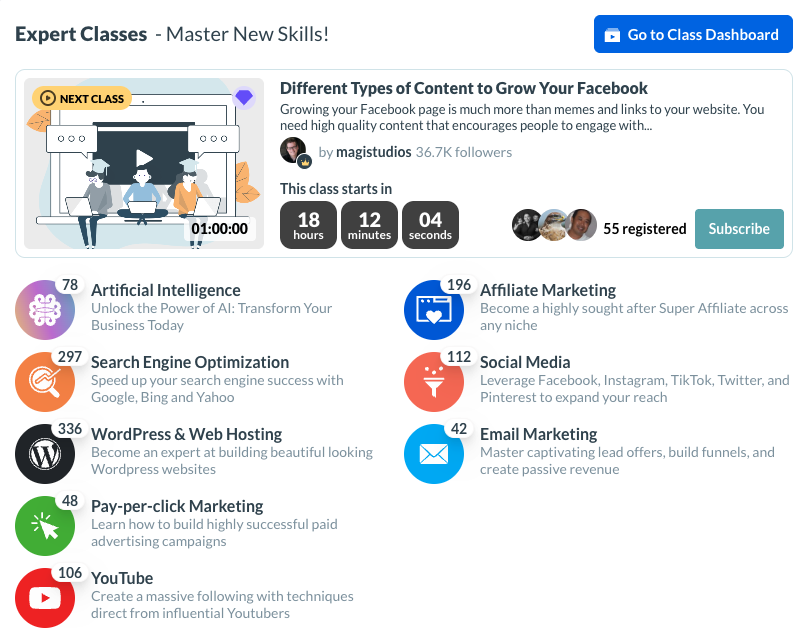So you’ve got a hobby that ignites your passion, and you’ve been wondering, ‘Could this fun pastime actually fill my wallet too?’ You’re not alone in this thought. With the surge of remote work and the gig economy, there’s never been a better time to transform what you love doing into something that also pays the bills.
Transitioning from a hobby enthusiast to a home-based entrepreneur takes more than just enthusiasm. It’s going to include a good dose of reality check: assessing your dedication, understanding the time you need to invest, and getting your finances in order for a smooth ride on the entrepreneurial roller coaster.
I’m here to help you navigate this transition. If you’re ready to consider whether your hobby has the chops to be more than just a hobby, keep on reading. You’re going to find out about laying down the groundwork, asking yourself critical questions, and starting off on the right foot. And let me tell you, planning is key—it’s not just about having fun anymore; it’s about turning that fun into funds.

Identifying Your Profitable Hobby
I’m going to show you how to turn what you love doing most into a moneymaker right from your own home. But before we talk about logistics, let’s determine if your hobby has the potential to pad your wallet.
Take a moment and list out all your hobbies. Got them? Great. Now, let’s evaluate which of these spark not just joy, but also show promise for profitability. You’re going to find out about the fine balance between passion and demand. Think about which of your skills can fill a niche or solve a problem for others. Is there something you’re making or a service you’re offering that friends and family are already willing to pay for?
This isn’t just about picking the most fun option. It’s also about seeking out current trends and analyzing what’s selling. Head over to online forums, local community boards, or social platforms and see what others are buzzing about. For instance, handmade crafts are booming on sites like Etsy, and if you’re a whiz at knitting or crafting unique jewelry, there could be a market waiting for you.
It’s now time to focus on market potential. Research to discover if there’s enough demand to turn your hobby into a full-fledged home-based gig. Don’t worry too much about competition just yet; first, ensure there’s an audience that’s interested in what you can offer.
If you’re having some trouble pinpointing your idea and whether it could actually become a business, try the tool below by clicking on the image, scrolling to the “Start Now By Finding A Business Idea”, then trying out some different ideas in the ‘search for an idea’ field:
Once you’ve honed in on a potential hobby to monetize, it’s time to think about how to draw in those who might be interested. Your passion can be infectious, and if you share it effectively, it can turn into profitability. So now, let’s move forward and plan how you’re going to take this hobby and structure it into a viable home-based gig.
Planning Your Home-Based Gig
So you’ve pinpointed a hobby that has the potential to generate income. That’s exciting, but now it’s time to get into the nitty-gritty: planning. Turning hobbies into a home-based gig isn’t just about doing what you love, it’s about creating a framework that allows your passion to sustain itself financially, legally, and practically.
Sketching out a business model may sound rather formal, but it’s essentially your roadmap. You need to figure out how you’re going to make money. Will you sell products, offer services, or perhaps a mixture of both? What’s your value proposition that sets you apart from the competition? And critically, how will you price your offerings to cover costs while remaining attractive to customers?
Setting goals is the next big rung on the ladder. And I’m not just talking about income targets. It’s about identifying specific, measurable, achievable, relevant, and time-bound (SMART) objectives. This could include sales milestones, expanding your product line, or building your customer base. But remember, your first attempt doesn’t need to be your last. You can always adjust your approach down the road.

One aspect you might not want to think about, but absolutely must, is the law. What permits or licenses do you need to operate your business at home? Are there any zoning regulations you have to consider? It’s critical to ensure you’re operating within the law to avoid any costly hiccups as your business grows.
By the end of this planning phase, you should have a clear strategy in place. But don’t worry too much about getting every detail perfect. This is a living document. The most important thing is that you’ve put careful thought into the foundation of your new venture. Next up, we’re going to talk about converting this foundation into a recognizable and relatable brand.
Branding and Marketing Essentials
Understanding that your hobby can intrigue others is one thing; transforming that interest into sales is another. I’m going to talk you through the branding and marketing must-haves for your home-based gig. Branding isn’t just a logo or a catchy name; it’s the entire experience you provide to your audience.
In my opinion, crafting an authentic brand identity is the cornerstone of success. It’s your brand that tells your story and connects on an emotional level with potential customers. Pick a distinct name, design a memorable logo, and find a color scheme that resonates with the message you want to convey.
Now, marketing might seem daunting at first but don’t worry too much about being a marketing guru from the get-go. It’s more about telling your story in a way that speaks to your target audience. You can always adjust your approach down the lines, based on feedback and results.
Social media is your ally here. Engage with platforms where your potential customers hang out. For some, that’s going to include Instagram, especially if what you offer is visual – think arts and crafts, or food. For others, it could be LinkedIn, if your hobby leans towards the professional side, like freelance writing.
Let’s not forget niche forums and community groups, either. These can be gold mines for home-based entrepreneurs. Engage with the community. Share your expertise without hard selling. Build relationships that can channel into your growing brand.
Remember, branding and marketing are dynamic processes. Your strategy needs to be flexible, evolving with you as your home-based gig blossoms.
There are plenty of free or low-cost resources that can help you. I personally love Canva to help with logo design and for sourcing and creating images. The free option should be more than enough to get you started with a logo and brand color palette.
And a for marketing essentials for your online business, look no further than my go training at Wealthy Affiliate. Your marketing training is thoroughly covered. Here’s a snapshot of the types of classes you can expect (that you do in your own time) that take you step by step through different marketing concepts. Looking at the image below, you’ll see the number of classes against each topic – there are 48 classes about different aspects of pay per click marketing; 112 classes relating to social media, 42 about email marketing, and another 106 classes about YouTube. It would cost tens of thousands of dollars in higher education fees to get this level of hands on, expert training.
Leveraging Online Marketplaces
You’re going to find out about tapping into the vast potential of online marketplaces. It’s here where your hobby can meet a global audience. But first, let’s zero in on picking a marketplace. It’s about aligning your unique offering with the right platform. Etsy is ideal for handmade goods, while eBay might cater to a broader array of products.
Getting noticed among thousands of sellers can be daunting. So here’s a strategy I like to leverage: strong product descriptions and quality imagery. Think of these as your digital shop window, enticing customers to come in.
But this isn’t just about setup, it’s also about understanding the costs. Each platform has different fee structures. You’ll need to figure out which platform’s fees align with your pricing model to maintain profitability.
Then there’s the community aspect. Engage with your customers through platform tools like messaging and reviews. Use their feedback to refine your offerings.
Remember, stellar customer service often translates to rave reviews and repeat purchases. And those reviews? They’re solid gold in the marketplace world. Not only do they build trust with prospective buyers, but they also help your products to rank better.
Your first attempt at selling might not be a home run, and that’s okay. User feedback can guide your tweaks and improvements, turning initial challenges into long-term wins.
Developing a Digital Presence
You will of course need your own website. This might sound daunting, but trust me, it’s easier than you might think.
I’m going to share tips on designing a website that’s not just a digital brochure but a place that turns curious visitors into satisfied customers. The key is user experience. You want a site that’s visually appealing, easy to navigate, and has clear calls to action. A service like WordPress can get you started even if you’re not a tech genius.
You can always adjust your approach down the line, but initially, focus on must-haves like mobile responsiveness, load speed, and an intuitive checkout process. Remember, you want people to linger, not bounce off because the site takes an age to load.
Now, onto the second piece of the puzzle: SEO, or Search Engine Optimization. Here’s where you make your website a beacon for search engines—and, by extension, potential customers. Infuse your content with keywords that resonate with your audience, structure your site with clear headings, and regularly update your content to keep things fresh. And if you look back at the training image I showed you earlier, you’ll notice that is LOADS of training about SEO and affiliate marketing.

Content creation is also part of this strategy. Think blogging about your hobby, creating how-to videos, and sharing insights that your audience can’t get anywhere else. This helps establish your expertise and can significantly boost your search engine rankings.
I really hope that you’re seeing how each of these steps is an intricate part of building a brand that stands the test of time. So when we talk about the next section, Financial Management for Your Home-Based Gig, keep in mind that what you’re investing in now with your digital presence will deeply influence your financial success down the road.
Financial Management for Your Home-Based Gig
You’ve got your home-based gig up and running, and it’s exciting to watch your bank balance grow as you monetize your hobby. However, to ensure this venture remains viable and profitable, it’s essential to get a solid grip on financial management.
Keeping a detailed record of every income and expense will not only provide a clear picture of your business health but will also simplify your life when tax season comes around. A simple spreadsheet might suffice at the start, but consider using accounting software as your gig grows.
Speaking of taxes, understanding the tax implications of running a home-based business is crucial. You might qualify for various deductions, such as a home office deduction, but you’ll also be responsible for reporting your income accurately. It might be wise to consult with a tax professional to navigate the complexities.
As you continue to profit from your passions, it’s important to remember to invest back into your business. This could mean upgrading equipment, investing in marketing, or taking courses to enhance your skills. Allocate your finances not just for the present but also for future growth.
Finally, don’t forget to pay yourself. It might be tempting to plow everything back into the business, but ensuring that you’re compensated for your time and effort is essential. This balance will keep you motivated and ensure the sustainability of your gig.
Now, what happens when your home-based gig starts to really take off? That’s when you should start thinking about scaling. Let’s explore how to expand your business while maintaining the joy and passion that sparked its inception.
Scaling Your Gig While Keeping the Passion Alive
You’ve laid the foundation for your home-based gig, and it’s gaining traction. Now, the challenge is to grow your business without losing the spark that ignited your passion in the first place.
The first step in scaling is to ensure you don’t overextend yourself. Your time and energy are finite resources, so choose expansion strategies that align with your capabilities and resources. For instance, introducing new products or services that are related to your core offerings can attract new customers without stretching you too thin.
Burnout is a real risk when you convert a hobby into a business. To sidestep this, carve time into your schedule to enjoy your hobby in its original, pressure-free form. It’s not just about work; it’s about continuing to love what you do.
Quality control can become more challenging as you grow, but it’s vital to maintain the high standards that brought your customers to you in the first place. Implementing checks or getting help can preserve the excellence of your product or service.
A fantastic way to amplify your passion is to collaborate with others who share it. These partnerships can lead to fresh ideas, split workloads, and shared resources, making your scaling efforts more sustainable.
Let’s round things off in the next section by talking about nurturing your business for the long haul. You’re going to find out about evolving alongside your customers, digging into the power of an engaged community, and why taking that first step could be the start of something amazing.
Nurturing Your Home-Based Gig for Long-Term Success
You’ve learned how to turn your hobby into a home-based gig and explored strategies to scale it responsibly. Now, it’s about ensuring that your newfound source of income can thrive for years to come.
Markets will change, and the importance of adapting can’t be overstated. Stay aware of trends and be willing to tweak your offerings. Keeping your finger on the pulse of the industry will help you anticipate changes and stay ahead.
Your customers are your biggest asset. Foster relationships with them, listen to their feedback, and create a community around your brand. This isn’t just smart business; it’s also incredibly rewarding on a personal level.
Finally, don’t be afraid to take the first step. You’re going to face challenges, but every entrepreneur does. What’s important is your resolve to overcome hurdles and your passion for your work. And remember, I’m here to help you along the way with advice, resources, and support.
I really hope that you feel inspired and equipped to transform your hobby into a profitable home-based gig. Choose something that resonates with you, that you can dedicate yourself to, and watch as it grows and succeeds. Thank you for reading, and here’s to your success!



